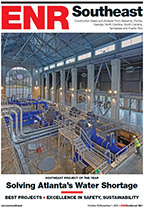A Jan. 18 Environmental Protection Agency memo could prove to be an important step in giving communities more flexibility in how they build and pay for major water infrastructure projects, according to water utility groups.
The memo stresses the agency’s commitment to working with the mayors of municipalities and localities on how regional offices evaluate the ability of communities to pay for major water infrastructure programs mandated by consent decree. In June 2012, EPA released a framework--called the integrated planning and permitting process (IP3)--for providing communities more flexibility in scheduling and prioritizing projects (ENR, 6/25/12).
Although mayors and other stakeholders were pleased with the framework as a first step, a key sticking point has been the way in which the agency and its regional offices evaluate the financial ability of communities to pay for water programs, says Chris Hornbeck, senior director for regulatory affairs at the National Association of Clean Water Agencies (NACWA).
To conduct financial capability assessments, regional EPA officials typically rely on 1997 EPA guidance that looks only at median household income, rather than other factors. That guidance, when followed strictly, could lead officials to underestimate the financial impact on individual communities, Hornbeck says. He adds that IP3, combined with “a more reasonable approach” to financial capability, might help communities that have been “paralyzed by the inability to do anything because they can’t do it all at once” move forward with major infrastructure programs.
EPA Deputy Administrator Bob Perciasepe told mayors attending the U.S. Conference of Mayors annual meeting in Washington, D.C. Jan. 17-20 that it is an agency priority to move forward with IP3.
New Bedford, Massachusetts Mayor Jon Mitchell (D) said that Perciasepe’s comments were “music to my ears.” However, he added, “My concern is whether EPA as an institution is ready for that flexibility.” He added, “Culturally within EPA, there is a resistance to flexibility…a rigidity…that might inhibit your approach.”
Perciasepe said, “We still have work to do to make sure our partners at the agencies and at the states all start growing in the same direction.” But he added, “There are a number of cities where this is going to take hold, and we are confident that it will be successful.”



Post a comment to this article
Report Abusive Comment